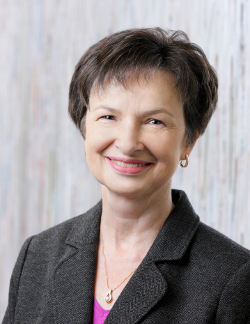Study shows virtual care removed barriers for patients during pandemic
 New research led by Bridget Ryan, PhD, showed physicians continued to provide a high standard of care during the pandemic.
New research led by Bridget Ryan, PhD, showed physicians continued to provide a high standard of care during the pandemic.
By Cam Buchan
While COVID-19 shifted primary health care from in-person to virtual care, family physicians continued to deliver a high standard of care for patients throughout the pandemic, including those with high needs, according to research at Schulich School of Medicine & Dentistry, Lawson Health Research Institute and ICES Western.
The move to virtual care – overwhelmingly through the telephone – also removed barriers for patients who rely on public transportation and for those who have difficulty taking time off work to access health care.
The study, recently published in BMC Primary Care, was led by Bridget Ryan, PhD, an assistant professor, in the Centre for Studies in Family Medicine, the Department of Family Medicine and the Department of Epidemiology & Biostatistics at Schulich Medicine & Dentistry.
 Bridget Ryan, PhD, assistant professor, Schulich Medicine & Dentistry
Bridget Ryan, PhD, assistant professor, Schulich Medicine & Dentistry
“It was encouraging to see quantitatively that patients seen during the early pandemic were on average older, with a higher percentage having multimorbidity, and more likely to be materially deprived; in other words, patients with high need,” said Ryan, also an associate scientist at Lawson and an adjunct scientist at ICES.
All physicians interviewed for the study reported that virtual care improved access for many of their patients. “In our interviews, family physicians told us how young moms with kids didn’t have to take three buses to get to their office or how trucker drivers travelling to the U.S. could do virtual visits for their diabetes with their family doctor from their cab,” said Ryan.
In contrast, family physicians who care for highly vulnerable patients, such as those experiencing homelessness, cautioned that virtual care was a challenge for those without access to telephones. Virtual care was also difficult for patients and family physicians in rural areas with limited access to reliable high-speed internet.
The study – which included both interviews and quantitative analysis – was done in London and Middlesex County. Through interviews and ICES data, the research team examined the rapid uptake and delivery of virtual care during the first and second waves of the pandemic from March to October 2020.
The volume of in-person visits dropped more than 72 per cent in the two weeks following March 14, 2020, driven by concerns for patient and staff safety, and an initial shortage of personal protective equipment (PPE) in family physician offices. Meanwhile, in those same two weeks, virtual visits made up more than 56 per cent of total visits. By June 15, 2020, in-person visits overtook virtual visits and by October 2020, overall family physician visit volumes had returned to pre-pandemic levels.
The study also revealed the inequity of different physician compensation models in Ontario. Physicians who were in capitation models received basic payments from the provincial government regardless of the overall decrease in total visits, while physicians in a fee-for-service model were paid only when they had an encounter with a patient and were more greatly affected by the initial overall drop. A delay in the Ontario government being able to accept virtual visit fee codes submitted through OHIP, meant that fee for service physicians experienced an almost two-month delay in receiving compensation for virtual care.
The move to virtual care has been seen in other Canadian jurisdictions and internationally in areas such as Australia, the U.S., China, Norway, Singapore, South Korea, Sweden and the U.K.
“Our study found the move to virtual care during the pandemic was primarily a move to telephone care rather than a move to video appointments; this highlighted for us that, when looking at the future of virtual care, we must consider the method of care delivery that is acceptable to both physicians and patients,” said Ryan.
Current work is now focusing on the future of virtual family physician care as the health sector emerges from the pandemic.








